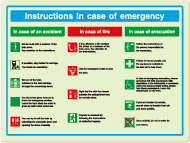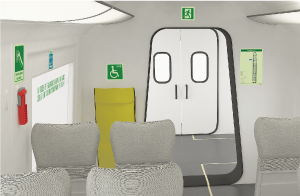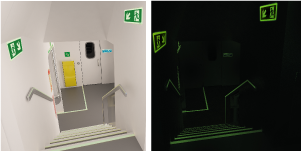Railway Group Standard GM/RT2130, Issue 4 – Vehicle Fire, Safety and Evacuation
|
Given the significance of the Railway Group Standard GM/RT2130, Issue 4 – Vehicle Fire, Safety and Evacuation for the railway public transportation sector, it is pertinent to highlight its prescriptions in terms of safety signs in this area of the catalogue. The Railway Group Standard GM/RT2130 is in line with the implementation of the Technical Specifications for Interoperability (TSI’s) mandated by several European Union Directives, namely Directive 2008/57/EC and its paragraph 2.4.1. Safety within Annex III Essential Requirements. Thus, this standard requires the provision of rail vehicle fire, safety and evacuation arrangements. Among other fire safety requirements, it specifically addresses the matters of emergency lighting, emergency and safety equipment and in its paragraph 6 it sets the Requirements for Emergency and Safety Information: 6.1. Provision of information 6.1.1 Emergency and safety information shall be provided to mitigate against the risks to people from the train and from the train operating in its particular environment. 6.2 General signage requirements 6.2.1 Emergency and safety signs shall be provided on rail vehicles to identify to persons conveyed by or working on rail vehicles, and to persons attending emergencies: a) The location, access and operation of equipment or facilities provided for use in an emergency. The image below provides an example of an emergency safety sign which can be used to identify the location of an equipment, in this particular case an evacuation chair, that shall be used in an emergency:  b) Actions that are prohibited for reasons of safety. The example below illustrates a prohibition action sign in compliance with this requirement:  c) Objects, actions, hazards and situations which affect or could affect safety. d) Instructions that are mandatory for the purposes of safety. The instruction panel below is an example of a sign that can be used to comply with this requirement:  Additionally to the general signage requirements, the Railway Group Standard GM/RT2130 also establishes specific requirements in terms of safety signs, from equipment that must be signed, location of the safety signs and materials of construction of the safety signs. 6.3.7 Equipment signage 6.3.7.1 On train safety signs shall be displayed where equipment is provided for passenger use. The signs shall provide clear information and instruction on the use of equipment. The image below shows an example of an equipment sign which provides clear instructions on how to use an equipment, in this case, on how to unlock the doors: 6.4 Positioning 6.4.1 Emergency and safety signs shall be positioned so as to be easily read and the information easily understood in relation to any necessary action. 6.4.2 The positioning of emergency and safety signs shall have priority over all other signs. 6.4.3 The number of signs used shall be kept to a minimum. This may be achieved by combining signs that are located in close proximity. The image below illustrates a simple but effective positioning of safety signs. At the entry/ exit point of this car there is an evacuation plan positioned at eye level to make it easy for the passenger to read and to become familiar with the emergency exits available as well as the locations of the emergency and fire-fighting equipment provided in the car. Over the exit door, there is an exit sign which can clearly be seen by all passengers irrespectively of where they may be travelling in this car. There is a emergency evacuation chair sign showing the location of that particular emergency equipment. The window shown in the image also features and emergency exit sign proving the information to the passengers that it can be used as an exit point in case of an emergency.  6.5 Materials 6.5.2 Signs provided for passenger emergency equipment, egress facilities and routes shall use photo-luminescent materials and shall not rely solely on the availability of emergency electric supplies. In the areas where photo-luminescent safety signs are used, the general lighting shall provide a minimum illumination of 50 lux, as required in paragraph 6.4.4, to ensure the signs are charged to be effective during an emergency that may arise.  As stated in its Part 8 Application of this document, the requirements of the Railway Group Standard GM/RT2130 are applicable to all new as well as to existing rolling stock when undergoing major modification that affects fire, safety and evacuation on vehicles. For more information on the available solutions in compliance with this or any other standard please e-mail us at commercial@everlux.com. |
